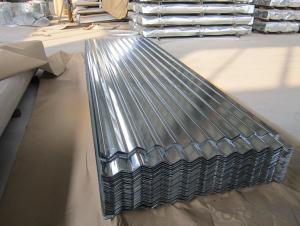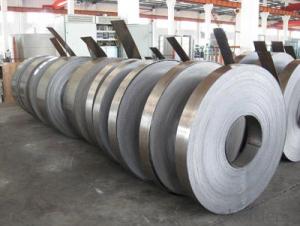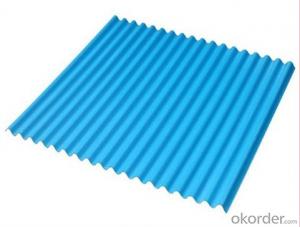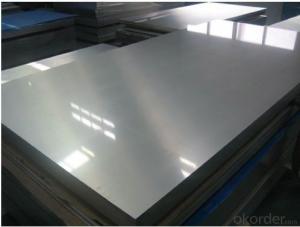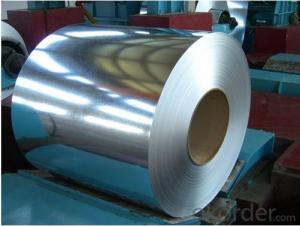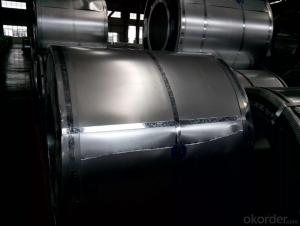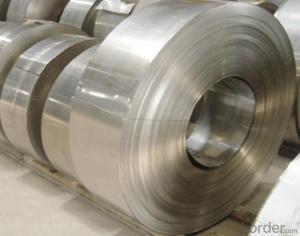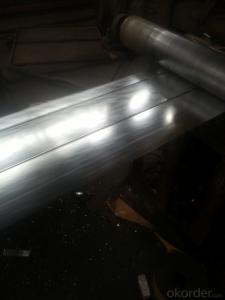Steel Coil/Hot Dip Galvanized Steel Strips Coil
- Loading Port:
- Tianjin
- Payment Terms:
- TT OR LC
- Min Order Qty:
- 1000 m.t.
- Supply Capability:
- 100000 m.t./month
OKorder Service Pledge
OKorder Financial Service
You Might Also Like
Steel Coil/Hot Dip Galvanized Steel Strips Coil Description:
Galvanized steel coil are widely used in the construction industry, as raw material for the production of corrugated panels, fencing products, drywall panel profiles, ventilation systems etc. Recommended for both outside and inside usage, galvanized steel has a high resistance to corrosion in different environments, due to a protective layer of zinc of 100 – 180 grams per square metre.
Main Feature of Steel Coil/Hot Dip Galvanized Steel Strips Coil:
Hot-dip galvanized steel coils are produced by immersing steel in a zinc bath. An appropriate galvanizing process requires a pretreatment process during which the steel passes through different baths which prepare the surface for zinc coating. In this stage, chemicals are used to clean the surface of the steel. After the chemical treatment, the steel coils pass through a bath of melted zinc at temperatures around 460 ° C. The resulting uniform coating is finished through a process of skin-passing to provide smooth and shiny appearance of the finished product. To store for a longer period, the hot-dip galvanized coils can be delivered with a final oil coating, according to the customer’s demand.
Steel Coil/Hot Dip Galvanized Steel Strips Coil Specification:
Steel strips coils galvanized
Material: Q195, Q215, Q235, Q345B, SGCC, DX51D+Z
Thickness:0.75-4.5mm
Width:32-750mm
Zinc coating: 60-550g/m2
Steel Coil/Hot Dip Galvanized Steel Strips Coil Images:

FAQ:
Q: Are you manufacturer of trading company?
A: Yes.
- Q:What are the safety precautions for handling steel strips?
- To minimize the risk of accidents or injuries when handling steel strips, it is crucial to implement various safety measures. Here are some important guidelines to consider: 1. Personal Protective Equipment (PPE): To safeguard yourself against potential hazards, always wear the appropriate PPE, such as safety glasses, gloves, and steel-toed boots. 2. Proper Lifting Techniques: Avoid strains or injuries by utilizing correct lifting techniques, including bending at the knees and maintaining a straight back, especially when dealing with heavy steel strips. 3. Secure Storage: To prevent falling or tripping hazards, store steel strips in a secure and organized manner, ensuring they are stacked properly and fastened securely. 4. Adequate Training: Prioritize providing comprehensive training on safe handling procedures, encompassing lifting, stacking, and moving steel strips, to all personnel involved. 5. Equipment Inspection: Regularly assess the condition of equipment like cranes, forklifts, or hoists used for steel strip handling, ensuring they meet safety standards and are in proper working order. 6. Clear Communication: Establish clear communication protocols among workers involved in steel strip handling to avoid accidents or misunderstandings. 7. Avoid Overloading: Prevent structural failures or collapse by adhering to the load-bearing capacity of equipment and storage areas when handling steel strips. 8. Watch for Sharp Edges: Exercise caution when dealing with steel strips, as their sharp edges can cause cuts or puncture wounds. Employ protective measures like gloves or edge protectors to minimize the risk. 9. Slips and Falls: Maintain clean and debris-free work areas to prevent slips or falls. Utilize non-slip mats or flooring, particularly in areas where steel strips are handled. 10. Emergency Preparedness: Establish a well-defined emergency plan that includes procedures for responding to accidents or injuries related to steel strip handling. By following these safety precautions, a safe working environment for all involved in steel strip handling can be ensured, effectively minimizing the risk of accidents and injuries.
- Q:What is the difference between strip steel and silicon steel?
- The sheet material rolled with silicon steel is the most widely used soft magnetic material in the field of electrical engineering. Therefore, silicon steel sheet is also called electrical steel sheet. Silicon steel sheets are widely used in motors, generators, transformers, chokes, electromagnetic devices, relays and measuring instruments. Influence of silicon content on properties of silicon steel sheet. Silicon is a good deoxidizer for steel. It combines with oxygen to convert oxygen into a stable, non carbon reduced SiO2, avoiding lattice distortion of iron by doping oxygen atoms. Silicon becomes a solid solution in alpha iron, increasing resistivity and helping to separate harmful impurities from carbon.
- Q:How are steel strips used in the manufacturing of bridges?
- Steel strips are commonly used in the manufacturing of bridges as they provide strength, durability, and flexibility. These strips are often used as reinforcement in the concrete structures of the bridge, such as in the beams and columns, to enhance their load-bearing capacity. Additionally, steel strips can be formed into various shapes and sizes to meet specific design requirements, ensuring the bridge's structural integrity.
- Q:How are steel strips used in the production of construction equipment?
- Due to their advantageous properties, steel strips find common use in the production of construction equipment. These elongated and thin pieces of steel play a vital role in enhancing the overall strength, durability, and reliability of the equipment. Reinforcement is one of the primary purposes for which steel strips are utilized in construction equipment. These strips are often integrated into the structural components of the equipment, such as chassis, frames, and supports, in order to provide increased strength and rigidity. The high tensile strength of steel ensures that the equipment can withstand the heavy loads, vibrations, and external forces experienced during construction operations. Additionally, steel strips are employed in the fabrication of wear-resistant components. Construction equipment is subjected to harsh working conditions, including abrasive materials, impacts, and repetitive movements. Steel strips with specific surface treatments or coatings can be utilized to create wear-resistant parts, such as blades, buckets, cutting edges, and teeth. These components can endure prolonged use without excessive wear and tear, thus extending the lifespan of the equipment. Besides their strength and wear resistance, steel strips are also favored in construction equipment due to their flexibility and formability. Manufacturers can easily shape and mold these strips into various complex geometries, allowing for the production of equipment with intricate designs and precise specifications. This flexibility enables the creation of construction equipment that can efficiently perform specific tasks, such as excavating, lifting, and compacting, with enhanced precision and maneuverability. Furthermore, steel strips are frequently employed in the manufacturing of connectors and fasteners for construction equipment. These connectors, such as bolts, nuts, and screws, hold different parts of the equipment together, ensuring structural integrity and stability. The high strength and corrosion resistance of steel strips make them ideal for such applications, as they can withstand heavy loads and exposure to various environmental conditions. In conclusion, steel strips are indispensable in the production of construction equipment as they contribute significantly to its strength, durability, wear resistance, flexibility, and overall performance. By incorporating steel strips into the manufacturing process, construction equipment manufacturers can produce reliable and long-lasting machines that can withstand the demanding requirements of construction projects.
- Q:How are steel strips used in the manufacturing of medical devices?
- Steel strips are widely used in the manufacturing of medical devices due to their unique properties such as strength, durability, and corrosion resistance. These strips are typically made from stainless steel, which is a high-quality alloy known for its exceptional mechanical and chemical properties. In the medical device industry, steel strips are used for a variety of purposes. One common application is in the production of surgical instruments such as scalpels, forceps, and scissors. These instruments require a strong and sharp edge, which can be achieved by shaping and sharpening steel strips. The stainless steel composition ensures that the instruments remain corrosion-resistant, minimizing the risk of contamination during medical procedures. Furthermore, steel strips are utilized in the manufacturing of medical implants such as pacemakers, joint replacements, and spinal fixation devices. These implants need to be robust and biocompatible to ensure long-term functionality and patient safety. Steel strips provide the necessary strength for these implants, allowing them to withstand the forces and stresses they may encounter within the human body. Steel strips are also used in the production of medical equipment, including imaging devices like X-ray machines and MRI scanners. These devices require a stable and rigid structure to maintain accuracy and precision. Steel strips provide the necessary structural integrity, allowing for the precise alignment of components and ensuring optimal performance of the equipment. Moreover, steel strips are employed in the manufacturing of medical tubing, catheters, and stents. These devices often require a combination of flexibility and strength to navigate through the body's intricate pathways. Steel strips can be shaped and formed into thin tubes or wires, enabling the production of flexible yet sturdy medical devices. In summary, steel strips play a crucial role in the manufacturing of medical devices. Their strength, durability, and corrosion resistance make them an ideal material for various applications in the medical industry. Whether it is for surgical instruments, implants, medical equipment, or tubing, steel strips contribute to the production of high-quality and reliable medical devices that enhance patient care and improve medical outcomes.
- Q:How are steel strips tested for straightness?
- Steel strips undergo a variety of methods to test their straightness. Trained professionals visually inspect the strips for any visible bending or warping. Straightedges or precision rulers are also used to check for deviations from a straight line along the length of the strip. Besides visual inspection, advanced techniques like laser measurement systems are utilized. These systems accurately measure the straightness of the steel strip by directing a laser beam along its length and recording any deviations from a straight line. This method provides precise and quantitative data, enabling a more objective assessment of the strip's straightness. Moreover, mechanical tests are conducted to assess the straightness of steel strips. These tests involve subjecting the strip to specific forces or stress, such as tension or compression, and measuring the resulting deformation. Any significant bending or curvature observed during these tests indicates a lack of straightness. In summary, steel strips undergo a comprehensive testing process to ensure their straightness. This process involves visual inspection, the use of straightedges or precision rulers, laser measurement systems, and mechanical tests. Employing these methods guarantees that steel strips meet the required straightness standards for various applications.
- Q:How is a steel strip made?
- A steel strip is made through a process called hot rolling, where a large steel slab is heated and passed through a series of rollers to reduce its thickness and shape it into a long, thin strip.
- Q:How do steel strips contribute to reducing transportation costs in various applications?
- There are several ways in which steel strips help to reduce transportation costs in various applications. First and foremost, steel strips are both lightweight and strong, which makes them perfect for constructing transportation vehicles like cars, planes, and trains. By using steel strips in these vehicles, their overall weight is decreased, resulting in improved fuel efficiency and lower transportation costs. Lighter vehicles require less fuel to move, which leads to reduced operating expenses and lower emissions. Secondly, steel strips are incredibly durable and resistant to wear and tear. This durability ensures that transportation vehicles made with steel strips have a longer lifespan, meaning they require fewer repairs and replacements. As a result, maintenance costs and downtime are reduced, leading to increased operational efficiency and lower transportation costs. Additionally, steel strips are versatile and can be easily formed into various components and structures. This flexibility allows for efficient design and manufacturing processes, which in turn reduces production costs. By using steel strips in the fabrication of transportation vehicles, manufacturers can streamline their operations, optimize material usage, and minimize waste, all of which contribute to lower transportation costs. Moreover, steel strips are readily available and can be produced in large quantities, making them a cost-effective option for transportation applications. The abundance of steel strips in the market ensures competitive pricing, allowing businesses to acquire the material at reasonable rates. This availability and affordability make steel strips an attractive choice for transportation manufacturers, enabling them to reduce overall production costs and subsequently lower transportation costs. In conclusion, steel strips play a crucial role in reducing transportation costs in various applications. Their lightweight yet strong nature, durability and longevity, versatility in design and manufacturing, and cost-effectiveness make them an ideal material for transportation vehicles. By utilizing steel strips, businesses can improve fuel efficiency, reduce maintenance and production costs, and ultimately lower overall transportation expenses.
- Q:Can steel strips be used in HVAC systems?
- Yes, steel strips can be used in HVAC systems. Steel is a versatile and durable material that can be used for various components in HVAC systems, such as ductwork, ventilation, and air handling units. Steel strips are often used for reinforcement and structural support in these systems due to their strength and resistance to corrosion.
- Q:Can steel strips be used in the production of shipbuilding components?
- Yes, steel strips can be used in the production of shipbuilding components. Steel strips are often used as raw material for manufacturing various shipbuilding components such as hull plates, frames, bulkheads, and other structural elements. The high strength and durability of steel make it an ideal material choice for shipbuilding, ensuring the structural integrity and longevity of the ship.
1. Manufacturer Overview |
|
|---|---|
| Location | |
| Year Established | |
| Annual Output Value | |
| Main Markets | |
| Company Certifications | |
2. Manufacturer Certificates |
|
|---|---|
| a) Certification Name | |
| Range | |
| Reference | |
| Validity Period | |
3. Manufacturer Capability |
|
|---|---|
| a)Trade Capacity | |
| Nearest Port | |
| Export Percentage | |
| No.of Employees in Trade Department | |
| Language Spoken: | |
| b)Factory Information | |
| Factory Size: | |
| No. of Production Lines | |
| Contract Manufacturing | |
| Product Price Range | |
Send your message to us
Steel Coil/Hot Dip Galvanized Steel Strips Coil
- Loading Port:
- Tianjin
- Payment Terms:
- TT OR LC
- Min Order Qty:
- 1000 m.t.
- Supply Capability:
- 100000 m.t./month
OKorder Service Pledge
OKorder Financial Service
Similar products
New products
Hot products
Hot Searches
Related keywords






